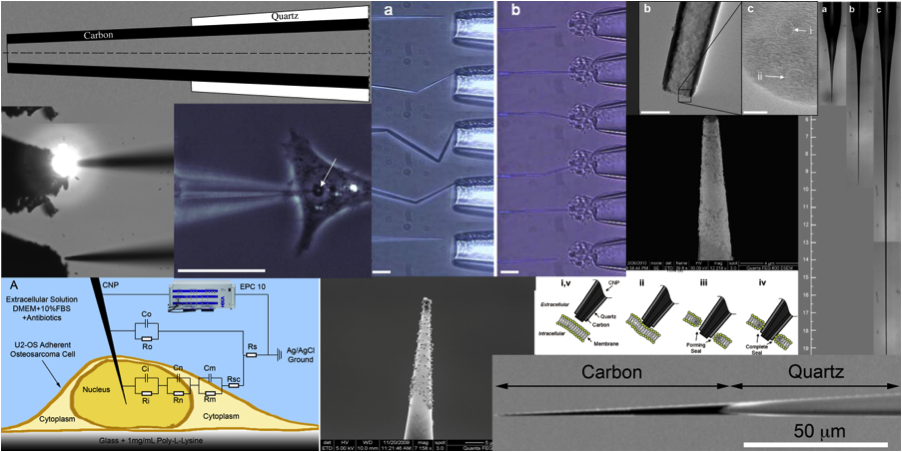The Carbon Nanopipettes (CNPs) consist of a pulled-glass/quartz micropipette with a thin layer of carbon deposited along its interior surface via a chemical vapor deposition process. The glass/quartz near the tip of the pipette is chemically etched to controllably expose the carbon pipe at the tip. The carbon pipe diameter ranges from tens to hundreds of nanometers. The result of this fabrication process is a nanoscopic, hollow carbon electrode incorporated and insulated within a glass/quartz macroscopic handle. The fabrication process does not require any assembly, overcoming one of the major challenges of nanotechnology – the interfacing between a nanostructure and a macroscopic handle.
The CNPs are compatible with standard electrophysiology equipment such as micromanipulators, patch-clamp amplifiers, and standard micropipette fittings. Since the CNPs are hollow, they can be used as injectors. Since the carbon tips are electrically accessible, the CNPs can also double as nano electrodes. To date, CNPs have been used for cellular microinjection of both fluorescent dyes and secondary cell messengers, providing improved durability and biocompatibility compared with their glass counterparts. They have also been used for cell electrophysiological measurements, recording cell polarization in response to chemical stimuli.
As an addition, an automatic injection system to obtain high-throughput process for the single cell injection research.
PUBLICATIONS
- Kim, B. M, Murray, T., and Bau, H. H., 2005, The Fabrication of Integrated Carbon Pipes with Sub Micron Diameters, Nanotechnology, 16, 1317-1320.
- Schrlau M, Falls, E., M., Ziober, B., L., and Bau, H. H., 2008, Carbon Nanopipettes for Cell Probes and Intracellular Injection, Nanotechnology, 19, 015101 (4p), doi:10.1088/0957-4484/19/01/015101.
- Schrlau M, Brailoiu, E., Patel, S., Gogotsi, Y., Dun, N., and Bau, H. H., 2008, Carbon Nanopipettes Characterize Calcium Release Pathways in Breast Cancer Cells, Nanotechnology 19, 325102.
- Schrlau, M., Dun, N., and Bau, H. H., 2009, Cell Electrophysiology with Carbon Nanopipettes, ACS Nano 3 (3), 563-568 (nn-2008-00851d.R1). http://pubs.acs.org/doi/pdf/10.1021/nn800851d.
- Schrlau, M., and Bau, H., H., 2009, Carbon-Based Nanoprobes for Cell Biology, Micro and Nano Fluidics 7, Issue 4, 439-450.
- Liu, C., Schrlau, M., Bau, H. H., 2009, Single bead-based electrochemical biosensor, Biosensors and Bioelectronics 25, 809-814.
- Anderson, S. E., and Bau, H. H., 2014, Electrical Detection of Cellular Penetration during Microinjection with Carbon Nanopipettes, Nanotechnology, 245102
- Rees, H. R., Anderson, S. E., Privman, E., Bau, H. H., and Venton, B. J., 2015, Carbon nanopipette electrodes for dopamine detection in Drosophila, Analytical Chemistry, DOI: 10.1021/ac504596y, Link
- Anderson, S. E., and Bau, H. H., “Carbon nanoelectrodes for single-cell probing”, Nanotechnology, 2015, (In Press)
